Sedum purple - a beautiful, tasty and healthy plant in your flower bed
Do you know what herb Ilya Muromets was cured with? He spent 33 years as a disabled person on the stove, and only the kaliki walking by, having given the squeaky grass to drink, healed him. And this is not only a beautiful fairy tale. The Roman naturalist Pliny wrote about the healing juice of this plant in the first century AD. Sedum purple, hare cabbage, live grass, squeaky, rejuvenated, thick-leaved - the flower has many names, and even more - legends and legends about its extraordinary abilities. This flower is in demand by herbalists in our "chemical" time.
- general description
- Beneficial features
- Chemical composition
- Pharmacological properties
- Contraindications
- Application in traditional medicine
- Other beneficial properties
- Varieties
- Varieties with purple coloration
- Purchase and adaptation
- Landing rules
- Selection of soil and location
- Necessary conditions for growing
- Humidity
- Temperature
- Lighting
- Care
- Top dressing
- Watering
- Transfer
- Reproduction methods
- Propagation by cuttings
- Reproduction by leaves
- Seed propagation
- Pests and diseases
- Useful videos
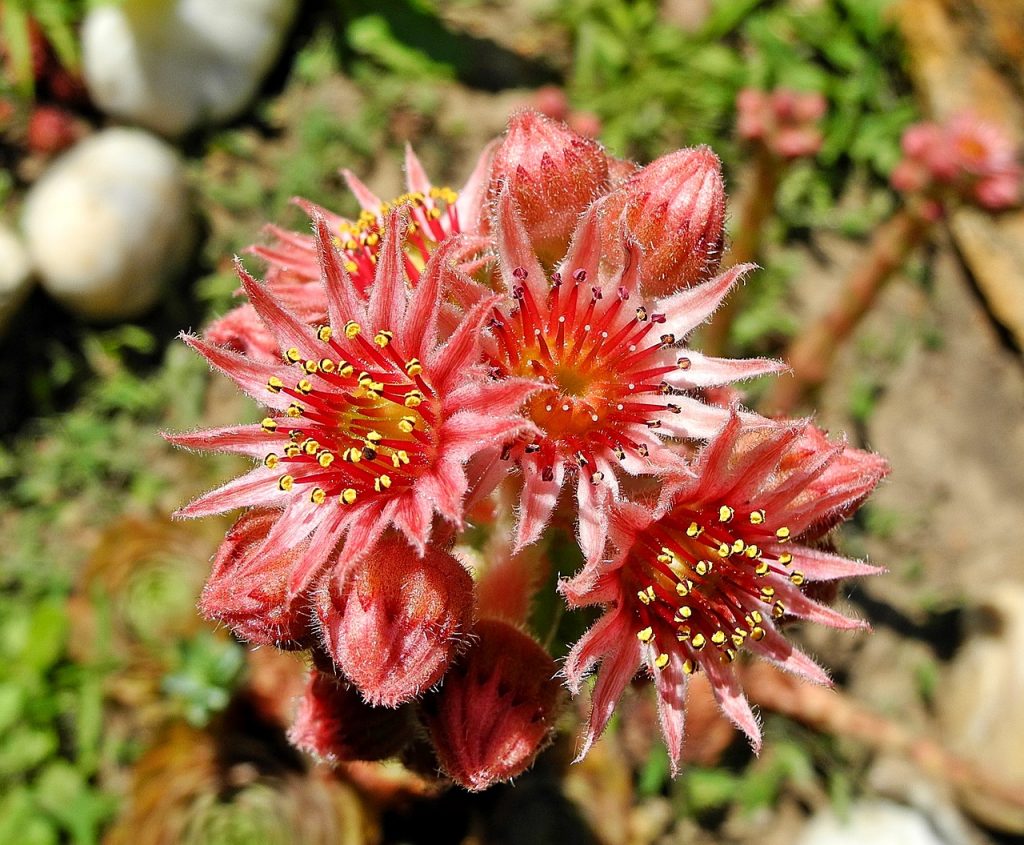
Sedum purple medicinal properties
general description
The biological name of sedum is sedum purpureum. He is from the Tolstyankov family (Crassul), a kind of stonecrop.
There are 2 versions of the origin of his name:
- from the Latin word "sedo" - to subside: the fleshy leaves of this plant relieved pain and fever;
- from "sedeo" - to sit, - the flower is pressed tightly to the soil, "sits". It has the same "sessile" leaves (firmly pressed to the trunk).
The genus includes about 500 species, distributed mainly in temperate latitudes.
Sedum purpureum is a perennial succulent plant capable of storing moisture. Its trunk is straight, smooth with oppositely located light green leaves, covered with a waxy bloom. From mid-July to late October, forms dark pink or purple inflorescences-shields of small stellate flowers. Sedum is a compact non-invasive plant up to 40-60 cm high.
Beneficial features
Purple sedum is one of the few plants that, according to popular wisdom, "will feed and heal." Its young leaves and stems have a pleasant sour taste, for which the plant received its second name - "hare cabbage". In the villages, the tender parts of the flower were consumed raw, they boiled cabbage soup, and fermented for the winter.
But the main feature of this sedum is its healing properties. They are preserved when dried, frozen and salted.
Chemical composition
A full-scale study of this plant has not been carried out, therefore, it has not yet been included in the list of medicines. However, the results of several studies on the identification of medicinal substances in this herb indicate a significant amount. Researchers from Russia, Mongolia, USA, Canada and England have proven the beneficial properties of purple sedum.

Sedum purpureum
And Prince Charles, an adherent of natural medicine, came up with a proposal to include it in the UK drug registry.
Consisting of:
- ascorbic, glutamic, citric and malic acids;
- vitamins;
- macro- and microelements;
- glycosides;
- alkaloids;
- flavonoids;
- saponins;
- carotenoids.
Pharmacological properties
Sedum purpureum belongs to the same family Crassulaceae, along with Kalanchoe and Rhodiola rosea, known for their healing properties. In contrast to them, all parts of the plant are useful in stonecrop.
This perennial is used for:
- treatment of rheumatism, fractures, purulent wounds;
- normalization of the gastrointestinal tract;
- restoration of kidney and bladder function;
- stabilization of pressure in case of hypotension;
- inhibition (slowing down, up to cessation) of the growth of atypical cells, including malignant ones;
- relief of pain in the stomach and intestines;
- reduction of febrile conditions;
- treatment of respiratory diseases.
The antiviral and antibacterial action of Sedum purpureum has been proven (Reports at the XVII International Scientific and Practical Conference on the Problems of Botany of Southern Siberia and Mongolia).
The healing properties of stonecrop ease the course of eczema, heal trophic ulcers, bedsores, fistulas. The anti-inflammatory effect is manifested in cystitis, pneumonia, bronchitis. (Research Department of Pharmacology, University of Florence, Italy. J Pharm Pharmacol. 2000 May; 52 (5): 585-91).
According to Cancer Research UK as of 2015, "There is currently no conclusive human evidence that herbal remedies can prevent or treat cancer."
And nevertheless, patients who, along with traditional therapy, were prescribed drugs from stonecrop purpurea, noted a significant improvement in well-being. A similar effect was observed in patients who took hemlock, however, the antitumor activity of stonecrop is much superior to hemlock and, unlike it, it is absolutely non-toxic.
Sedum Purple is one of the most powerful immunostimulants that surpasses aloe and hemlock in terms of impact, while being more gentle.
It is also used in ophthalmology and otolaryngology.
Contraindications
Sedum purple is not recommended:
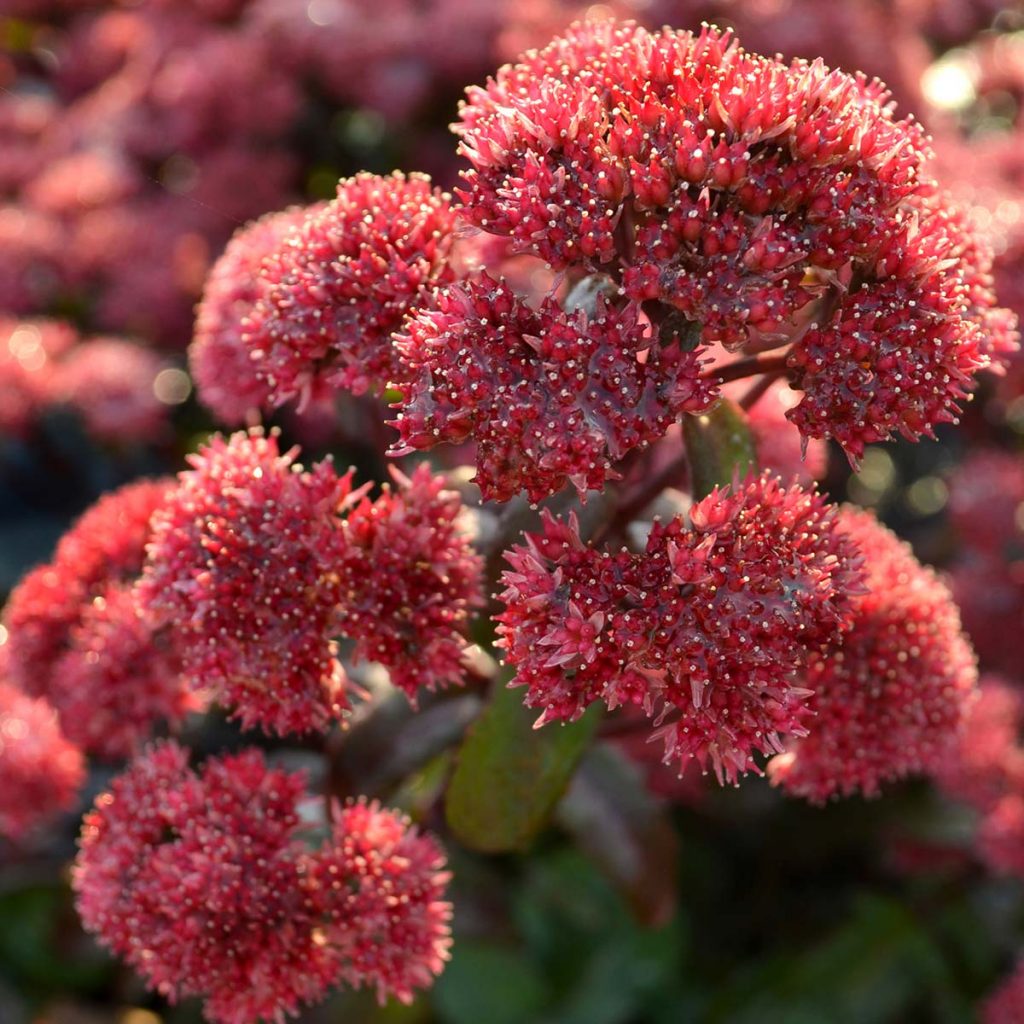
Sedum purple photo
- lactating women;
- hypertensive patients;
- allergy sufferers with intolerance to sedum ingredients;
- patients with acute gastritis.
The tool can be used only after consultation with the attending physician, in the form of additional therapy. In this case, the dosage should be strictly adhered to: an increase in concentration can provoke vomiting, migraine, confusion.
Application in traditional medicine
Use all parts of the plant, dried, frozen or fresh. Herbalists recommend several recipes.
1. Infusion. Pour 20 g of dry grass with a glass of boiling water, leave for 2-3 hours, strain and take according to the following scheme:
- 1 tbsp 1-2 times a day - to strengthen the immune system;
- 2 tbsp 3 r / day - with a breakdown, impotence, bowel disorders;
- 3 tbsp 4 r / day - for malignant neoplasms.
2. Decoction from the roots. Chop 100 g of fresh or frozen tubers, pour 1 liter of cold water. In a water bath, heat to a boil, keep for 20 minutes. Consume 1-2 tbsp. l with uterine myoma, ovarian cystosis, adenoma, prostatitis.
3. Ointment. Squeeze out the juice, mix with the "Baby Cream" until a homogeneous suspension is obtained, apply to the affected skin.
4. Alcohol tincture. Pour 200 g of fresh shoots with 0.5 l of vodka, insist for 3 weeks in a dark place at room temperature. Apply daily 20 drops dissolved in 1 tbsp. l of water for the treatment of respiratory diseases, hypertension, sinusitis.
Among sedum, there is only one poisonous species - stonecrop, but yellow flowers distinguish it from purple sedum. Therefore, when self-procurement of medicinal raw materials, attention should be paid to the color of the flowers.
The aerial part is cut off during the flowering period - at this time the plant contains the maximum amount of medicinal substances. To preserve all the useful ingredients, the stems are scalded with boiling water to stop their further development, and dried first at 60C and then at room temperature.
The roots are dug out at the first frost.Frozen stems, leaves and tubers retain their beneficial properties for 2 years, dried ones - up to 3 years.
For medicinal purposes, it is safest to purchase sedum purple in pharmacies. When purchasing, you need to make sure that the medicinal raw materials comply with the state sanitary and epidemiological rules and regulations: SanPiN 2.3.2.1078-01 "Hygienic requirements for the safety and nutritional value of food products."
Other beneficial properties
Purpureum sedum extracts are used in shampoos and care products for dry and sensitive skin. They contain tannins and glycerin for long-lasting moisturizing effects.
Landscape designers consider this sedum to be the most rewarding plant. It is unpretentious, grows where not a single flower will survive, decorates the garden from early spring to frost. The common name for Sedum is Stonecrop (stone culture). Many gardeners joke that only stones need less maintenance and live longer.
Varieties
Sedums are a large group of succulents known for their colorful foliage, fragrant flowers, and tolerance for growing conditions.
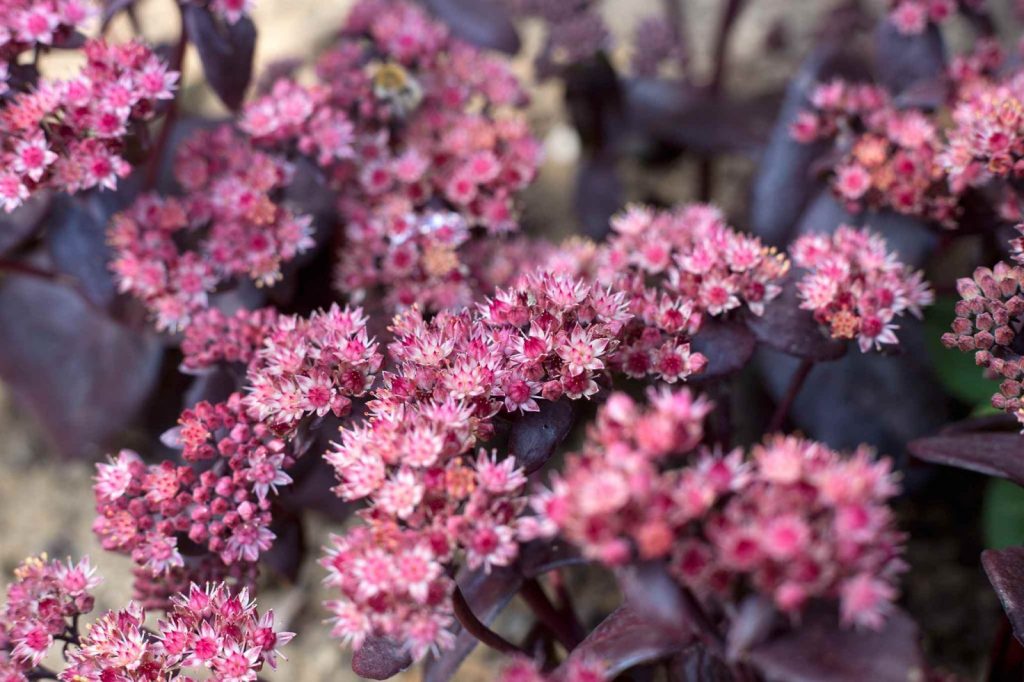
Squeaky grass
There are 3 classes of these plants:
- ground cover (Eversa, Kamchatsky, etc.);
- ampelous (False, Morgana);
- tall (Ordinary, Vidny, etc.).
Varieties with purple coloration
Sedum spatulate "Purpureum" (Sedum spathulifolium "Purpureum").
An extraordinarily attractive evergreen groundcover that forms a dense carpet 5-8 cm tall. Fleshy leaves in the form of a rosette up to 3-5 cm in diameter. Young leaves are covered with a silvery-gray waxy bloom with a burgundy border. The old ones are pure purple. Flowering shoots up to 10 cm long, ending in an umbellate inflorescence of pinkish-yellow flowers. Blooms from July to mid-August.
Sedum spathul requires shelter in late autumn, in snowless frosty winters it can freeze out. With proper care, it can withstand frosts down to -28C.
Sedum Emperor Purple
A hybrid based on sedum purple. Winner of the Garden Merit Award of the Royal Horticultural Society (UK) for 2002. Recognized as the best ornamental sedum in the ranking of the Chicago Botanic Gardens - 2008.
It stands out with dark purple, almost black leaves that densely cover compact purple stems up to 60 cm high. Small salmon and pink flowers are collected in massive flat heads.
Maintains rich color throughout the season. It blooms from mid-June to frost (until the end of October). A magnificent honey plant, attracts with the aroma of butterflies, bees and bumblebees. Shoots die off for the winter. Withstands frosts down to -30 ° С without additional shelter.
Sedum Atropurpurea (Atropurpureum)
It is characterized by a purple coloration of elongated cylindrical fleshy leaves. Belongs to a ground cover species, reaches a height of 15 cm. Forms a loose carpet of maroon shades.
The leaves are overwintering, in cold and snowless winters it can freeze out, but it is easily restored - the shoots grow from the root. The flowers are white, collected in a paniculate inflorescence. It blooms for 2-2.5 months, starting in June.
Purchase and adaptation
When purchasing a plant in a nursery, special attention should be paid to the leaves of the seedling.

Sedum purple
In a healthy stonecrop they:
- varietal color;
- hold tight to the stem;
- have a good turgor and a shiny surface.
If you deviate from these parameters, the plant is not worth buying.
Adaptation to healthy sedums is not required. In the event that the shoot is planted on a site in direct sunlight, it is recommended that in the first 7-10 days arrange for it a light partial shade and more frequent watering.
Landing rules
Under natural conditions, sedum grows on any type of soil - in floodplain meadows, forest edges, on clay slopes and in rock crevices. The area of distribution is almost the entire Northern Hemisphere.
Selection of soil and location
The plant needs loose soil with good drainage properties.This perennial can grow on sparse rocky or sandy soils, but will die in dense clay soil. Moderate addition of rotted organic matter will ensure lush, long lasting flowering and good growth.
When landing, you need to follow these steps:
- a 5-7 cm layer of fine gravel or brick is laid on the bottom of the pit;
- the soil is freed from weeds and their roots;
- fill 1/3 with sifted substrate, tamp;
- the seedling is placed in a hole and sprinkled with a layer of cleaned earth mixed with sand;
- compact the soil around the stem;
- watered.
Necessary conditions for growing
Sedum purple is undemanding to soil fertility, tolerates frost and drought well. The flower can be grown in the garden, in a container in the country, on the balcony, providing it with minimal conditions.
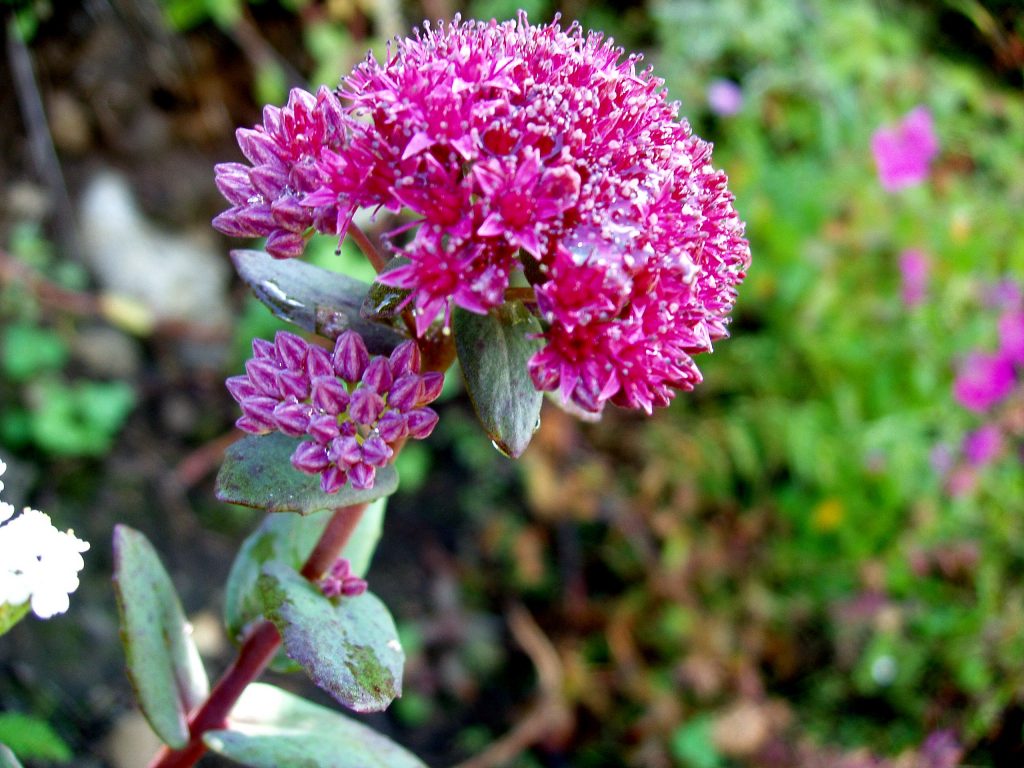
Sedum purple recipes for use in traditional medicine
Humidity
Purple sedum tolerates drought better than excessive moisture in the air and soil. Wetlands, proximity to water bodies, stagnant water provoke the appearance of root rot. During the rainy period, it is necessary to loosen the soil to aerate the roots.
Temperature
The culture tolerates both high summer temperatures and winter frosts (down to -30 ° C). In the central regions of Russia, there is no need for additional shelter for the winter. In colder climates, especially with snowless winters, it is recommended to insulate the plant with spruce branches or covering material. When the aboveground part freezes, the shoots sprout from the root.
Lighting
Sedum is picky about the amount of sunlight during the day. In the shade of trees, bushes and buildings, sedum stretches out, loses its decorative effect. A rich color and abundant flowering are possible only under the condition of at least 6-8 hours of direct sun. But Stonecrop purple is not afraid of drafts and winds.
Care
There are several rules for caring for sedums outdoors.
Top dressing
Additional nutrition is necessary for the "purple healer" for abundant flowering and the accumulation of nutrients, especially if it grows next to other flowering crops.
As a source of nutrition, you can use wood ash, humus or complex mineral fertilizers, optimally - compositions for succulents.
Top dressing is carried out once a year, in the spring or immediately after flowering. An excess of nitrogen in the autumn is unacceptable - this will weaken the plant before wintering.
Watering
Additional soil moisture is required by stonecrops during long periods of hot, dry weather. The rest of the time, the culture has enough natural precipitation.
After watering, you need to loosen the soil around the plant to prevent soil compaction. An important condition for growth is the timely removal of weeds. When daytime temperatures drop, watering is stopped.
Transfer
The cleaning procedure must be carried out every 4-5 years. So it will restore its decorative and healing qualities. This is often combined with a transplant.
To do this, the bush is dug up, old and damaged shoots are removed, the plant is divided into several parts so that each has a tuber, and planted in a new place. The operation can be carried out in the spring (preferably) or in the fall, 3-4 weeks before permanent frost.
Reproduction methods
Sedums are easy to reproduce, and once in the ground, they spread on their own, gradually covering the rocky slopes and rock gardens. In nature, they reproduce by self-seeding or by shoots at the base of mature plants.
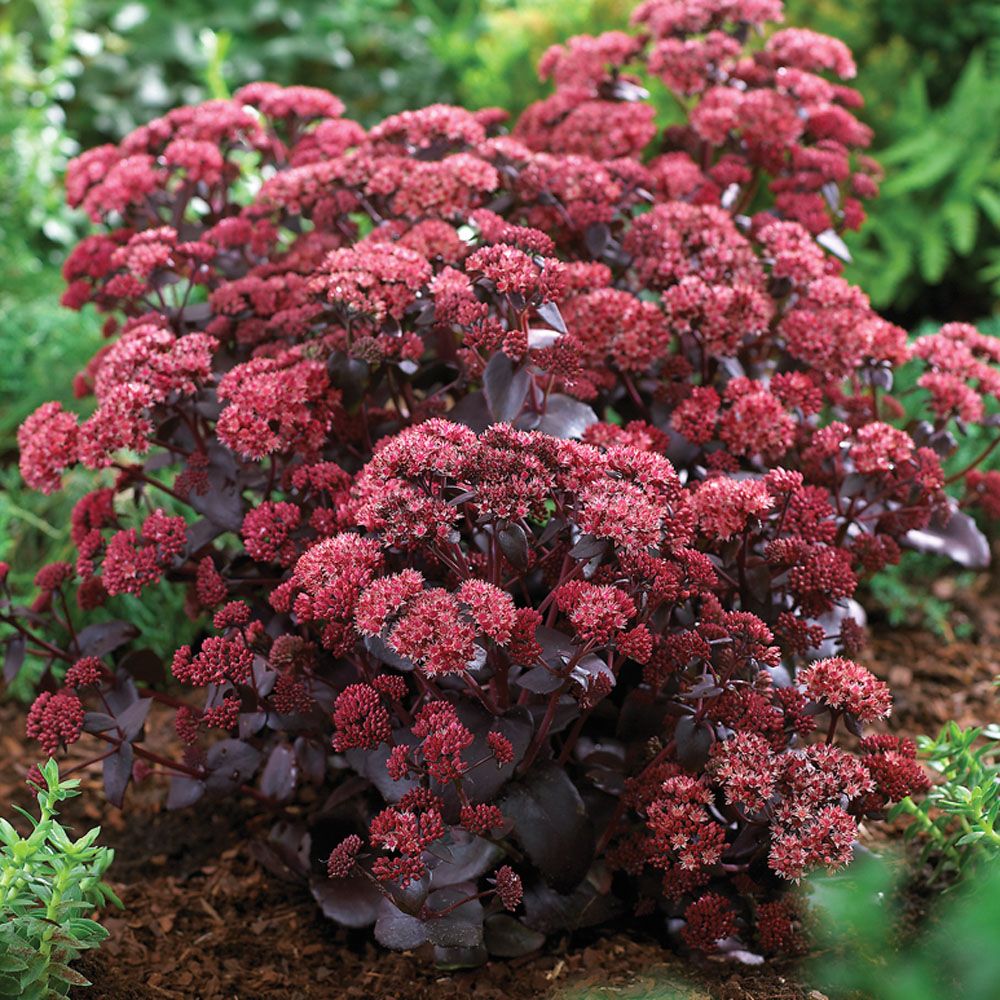
Sedum purpureum
There are 4 ways to effectively reproduce sedums:
- seeds;
- leaves;
- cuttings;
- by dividing an adult plant.
Delenki bloom in the first year, seedlings from leaves or cuttings - in the second year, from seeds - in the third.
Propagation by cuttings
This is one of the easiest and most reliable ways to breed sedums. It is necessary to cut off 10-12 cm from the top of the plant, remove the lower leaves and deepen the lower end of the cutting by 1-2 cm into wet sand. After about 2-3 weeks, the first roots will appear.
Reproduction by leaves
Every healthy stonecrop leaf is a potential new plant. It is necessary to break off a leaf blade with an increased turgor and place it with its base in a moist substrate. After 2-3 weeks, sprouts will appear, which can be transplanted into a separate container.
Seed propagation
This process takes a long time, and the likelihood of a favorable outcome is much lower than with other breeding methods. But the most important thing is that hybrid varieties do not transfer their properties during seed propagation, in contrast to cuttings.
To propagate stonecrop with seeds, it is enough to place them in wet sand and gently press down without covering them with earth. At a temperature of 25-30 C and sufficient humidity, they will germinate in 3-4 weeks.
Pests and diseases
Proper care of the sedum will provide the best protection against disease. A strong plant is capable of successfully fighting pests.
| Diseases / pests | Prophylaxis | Treatment |
| Rot | Avoid excessive soil moisture, loosen, remove weeds | Plant removal, soil treatment with fungicide |
| Aphid | Regular inspection, mechanical methods of dealing | Insecticide treatment |
| Sawfly | ||
| Weevil | ||
| Slugs | Cover the root space with small pebbles with the addition of special granules for the destruction of snails and slugs. |
Sedums are ideal plants. Who can resist an energetic and beautiful flower that does not require worries and blooms for several months? Having planted it in the garden, you can enjoy the bright bushes all summer, and in the fall you can prepare useful shoots for your first aid kit. Good health!


